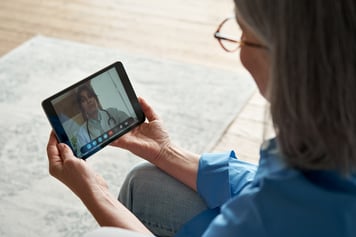A Kaiser Family Foundation state indicator report has found that almost one-third of the U.S. population lives in a Primary Care Health Provider Shortage Area (HPSA). This means that a significant number of people are lacking access to the essential primary care services they need for better health outcomes, improved care management and lower healthcare costs.
Primary care is crucial for the early detection and management of chronic diseases, reducing hospitalizations and emergency room visits, and promoting overall wellness. However, due to the shortage of healthcare providers, many adults cannot access the primary care they need.
Virtual primary care provides patients with easy access to care, whenever and wherever is most convenient for them. It can be provided to employees and their families at little-to-no cost, removing access barriers and increasing care equity. Through virtual primary care, people are also more likely to seek care when they need it, improving health outcomes and preventing more serious health issues from developing down the line.
What is a Health Provider Shortage Area (HPSA)?
A designated HPSA indicates an inadequate number of healthcare providers for population groups (a patient to physician ratio of 3,500:1). These designations consider the healthcare needs within the populations relative to the number of physicians available.
Here are the top 10 states that could use virtual primary care the most based on the population sizes living in HPSAs (as of November, 2023):
- California: Currently, more than 8 million live in a designated HPSA – almost 1 in 5 adults.
- Florida: About 7.9 million live in a designated HPSA – more than 1 in 3 adults.
- Texas: Nearly 7.5 million live in a designated HPSA – almost 1 in 4 adults.
- New York: Over 6.5 million live in a designated HPSA – 1 in 3 adults.
- Illinois: 3.7 million live in a designated HPSA – almost 1 in 3 adults.
- Michigan: More than 3.5 million live in a designated HPSA – more than 1 in 3 adults.
- Washington: More than 3.5 million live in a designated HPSA – almost 1 in 2 adults.
- Georgia: Nearly 3.4 million live in a designated HPSA – almost 1 in 3 adults.
- Arizona: More than 3.3 million live in a designated HPSA – almost 1 in 2 adults.
- North Carolina: More than 3.3 million live in a designated HPSA – almost 1 in 3 adults.
About First Stop Health Virtual Care
First Stop Health Primary Care, Urgent Care and Mental Health solutions deliver patient-first, $0 care to members where and when they need it. As First Stop Health runs independently from carriers, virtual visits do not incur claims, all members are pre-registered for easy access to their accounts and implementation is turnkey. First Stop Health puts its fees at risk and offers performance guarantees on utilization or return on investment to ensure solution efficacy.
Primary Care: A Virtual Home Designed for Everyone. We aim to be a virtual medical home for patients and to meaningfully change the way they think about a primary care relationship. Scheduling is available as soon as next day with a virtual doctor for chronic issues and prevention. Members currently have access to urgent care plus a wrap network of health coaches, dieticians, physical therapists and onsite biometrics starting, as well advocacy and steerage from registered nurses that goes beyond care coordination.

Primary Care
Holistic, patient-centered Primary Care focuses on treating the whole person
Learn moreTable of contents



